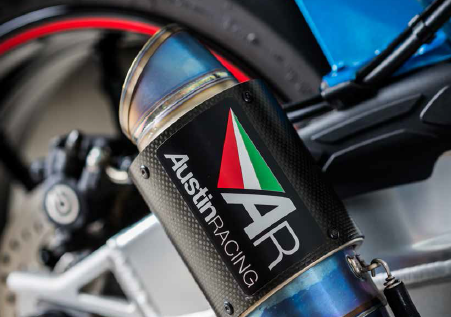It's a racing certainty
When sports bike enthusiast Rich Austin decided to make a custom exhaust for his motorcycle, he had no idea it would turn into a business that sells products across the world. We visited Austin Racing to find out more about his journey.
For sports bike owners, it’s common practice to upgrade their exhausts from the factory supplied item. In 2009, when Rich threw all his savings into a new Aprilia RSV4, he was keen to do just that. However, he could find nothing on the market that had either the look or the sound characteristics he wanted for his motorcycle. Rich decided his only choice was to buy some components and make one himself. He wasn’t an engineer, but since he first had a motorcycle, he’d always tinkered with and customised his own exhausts. So he decided to give it a go and set about the task. The starting point was to form the shape he had in mind, from a strip of scrap aluminium, and take it to a tube bending company who could produce a pipe from his pattern. He then bought a silencer that was close to his vision, customised it to get it just right and then fitted both to the bike. Rich was happy with the results. It looked and sounded great.
Proud of his achievements, Rich put pictures on an American web forum aimed at Aprilia owners. Within a couple of days, messages came through asking where he’d got the exhaust system. When Rich explained that he had made it, the responses turned into requests from other owners to make them one. Pleased with the reaction from fellow enthusiasts he made five more and sold them on at cost. And then the word started to spread. Very soon Rich had 20 more requests, then there were 30, and in just a few days he had 50 orders.
That was when Rich realised he had an eye for designing sports bike exhausts and that he might just be able to make a living from his passion: Austin Racing was born.
It was only a month since he’d made his first exhaust Rich updated the design a little, tightened up the production process and made 50 more. He sent those out to his customers, and more enquiries started to come in. This time, they were from owners of other styles of motorcycle, all wanting a similar look. When asked why he felt there was such strong interest in his design, Rich explained that there were no alternatives. “I’d modelled my look on the exhausts used on Moto GP bikes at the time because I liked the style. I don’t know why, but no other exhaust manufacturer was producing anything similar, so for other people who had similar tastes, mine was the only option,” he commented. “Then I realised I could follow my passion and attempt to turn this into a great company, something very special.” Rich continued. “I put many, many, hours of research into exhaust and materials theory and design, spending time with a friend that worked in exhaust design with a leading F1 manufacturer. This gave me a great deal of knowledge of just what it takes to produce exhaust systems that perform and sound as good as they look.”
Today, the exhausts they make are based on the same visual design principles, but they have come a long, long, way in technical terms. And, from the single initial model the company now produces systems for more than 30 motorcycles with several versions for each.
Rich and the team have worked hard to make sure they are continually evolving their design, to take advantage of the best new techniques and materials as they become available. The most notable feature they have introduced is to allow the noise levels (dB) to be controlled without any impact on the motorcycle’s power. This capability is a hugely popular feature, for both limits placed at racetracks and in some of their international markets, but also for personal preference. And it is unique to the systems built by Austin Racing.
Understandably, Richard keeps the details of how this is achieved close to his chest. Users can tune the system within a 100-125dB range. The traditional approach to reducing noise has been to use a device known as a ‘dB killer’, but this also hurts powe output. Rich has designed his method to use a system that controls dB levels but has no impact on power output. “It was relatively easy to come up with the initial concept for this feature,” said Rich. “However, we spent a lot of time researching and testing options to find the most effective solutions and materials. That process is ongoing, and we are always looking to up-rate and improve our exhausts.”
A lot of development work is done in partnership with suppliers. The company that supplied the titanium tubing for their systems is a good example. Their experience was also developed, in part, from working with Formula 1 teams. It proved invaluable in helping to move to the use of Inconel 625, a material considered superior to titanium for its heat handling properties and strength. “I’ve learnt so much from working with our suppliers, some of which I would previously never have considered. For example, the common belief is that a free flowing exhaust is preferable, but I have learned that this is not always the best way to go.” Rich added.
The latest range in Richard's journey has been a significant step for him and the company. Last May he took the decision to bring everything he could in-house which has required a huge investment in machinery, with some sophisticated equipment needed to deal with the materials used in production. Bending and cutting the titanium and Inconel tubing is a specialist process, as is welding these materials. However, it gives Rich an increased level of control over the quality of the products, and his ability to react more quickly to the market. Both areas of the business he believes are critical to its success. “It is vital that everyone on the team is on board, which they are. While it was a little scary, this new capability has given us a level of flexibility we didn’t have before,” Rich commented. “When a new bike comes on the market, we can get one into our factory, have a prototype system done in a day and begin testing and refining it the very next day. It means a new system can be available to our customers within a week of a motorcycle’s launch. None of the other manufacturers, particularly the larger ones, can move that quickly, so it gives us a real advantage,” he concluded.
Not many people can turn a passion into a living, but Rich has proved it is possible. So the next time you creat something to solve your own problem, it may be an idea not to keep it to yourself.
Austin Racing has worked with Breakthrough funding, a company that helps UK SMEs achieve R&D tax credits - a government scheme created to enhance and reward innovation amongst UK businesses. Could you be eligible? Click here to learn more.
For more information, click here.




